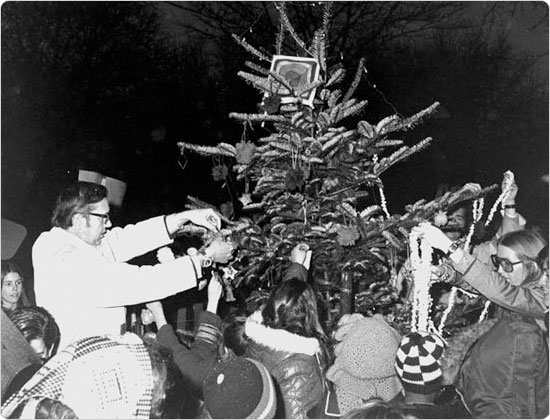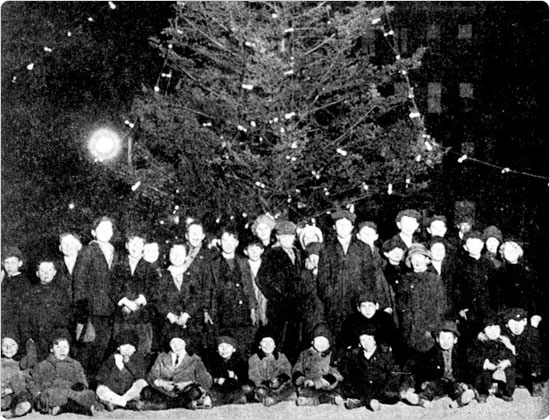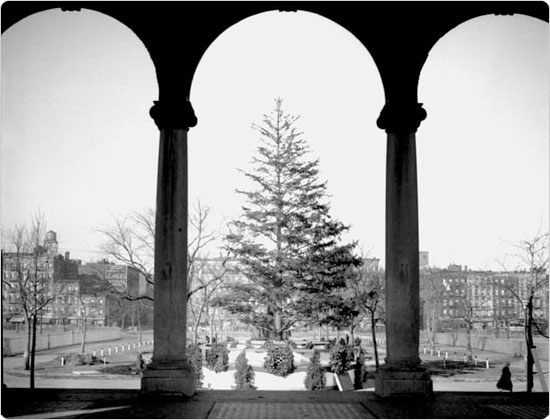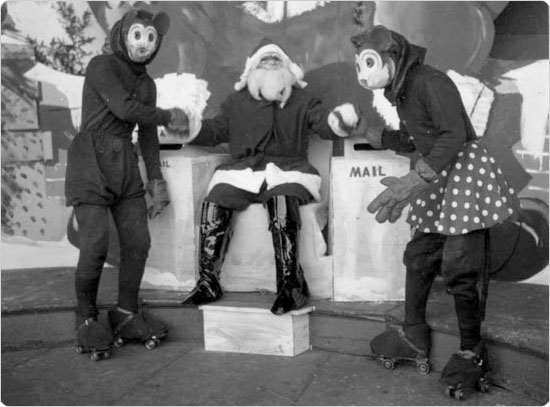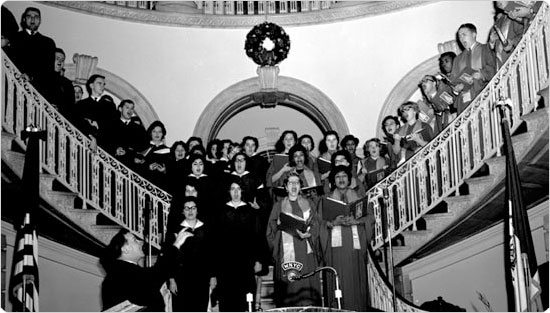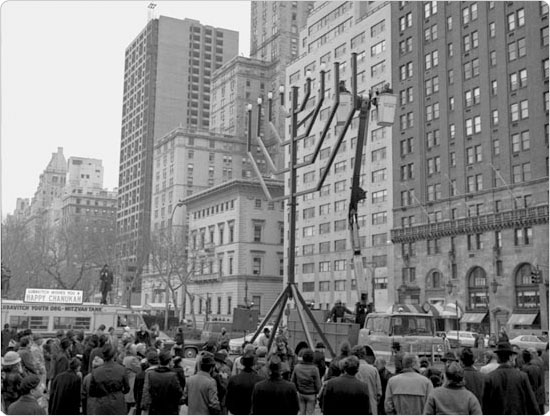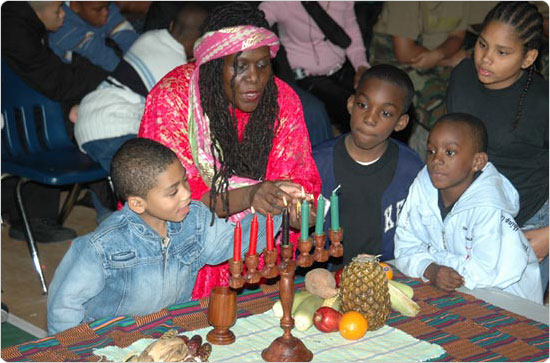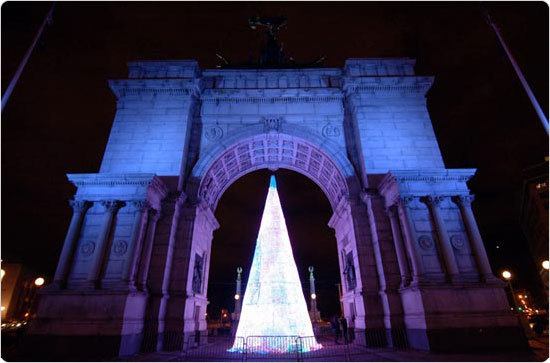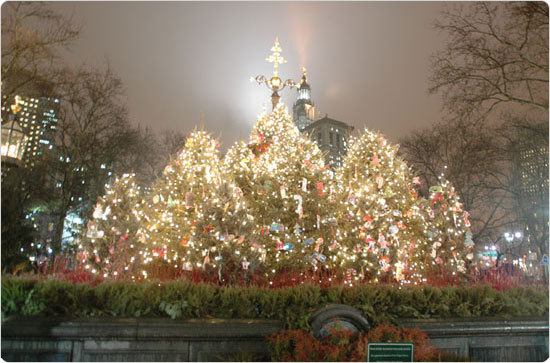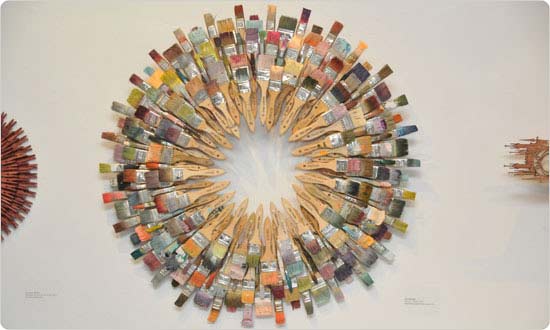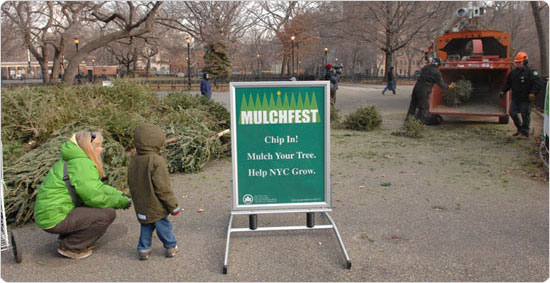History of Holiday Celebrations in Parks
For more than a century, the Parks Department has participated in the civic celebrations that accompany the holiday season, whether by contributing trees, sponsoring festive programs, or working with community groups to celebrate the season.
Early Municipal Celebrations
Parks Annual Reports detail celebrations in 1911 in Manhattan when officials organized holiday festivals, providing Christmas trees to decorate and lending music, in the form of the agency's playground organ, for dancing and revelry. In 1912, Madison Square Park hosted a municipal Christmas Tree Lighting ceremony, and the annual City Hall Christmas Tree Lighting ceremony began in 1913, initiated by acting mayor Ardolph Kline. The Star of Hope monument in Madison Square marks the approximate location of the first tree lighting. The Washington Square Association began its tree–lighting tradition in 1924 in annual events that also featured the singing of holiday songs and carols; the tree framed by the majestic Washington Arch is one of the city's iconic images. At one time, the Washington Square Arch and the Soldiers and Sailors Arch in Brooklyn were lit with lights as well.
In Brooklyn in 1920, a 40–foot Christmas tree was erected in Prospect Park and decorated with 600 red, white, blue, green, and purple electric bulbs. A 50–foot community tree in 1926 surpassed the 1920 tree by ten feet and added 600 more colored electric lights. Paid for by local civic organizations, the annual report noted that it “made a splendid appearance and could be seen from many streets and avenues approaching the park.” The annual report also noted Christmas trees set up at different points around the park that “when lighted during Christmas time, the illumination cast weird shadows through the trees and was much admired by people who visited the park to witness the display.” Three hundred school children from PS 9 sang Christmas carols around the tree “very much enjoyed by those present,” which included a version of “The Star Spangled Banner,” “O Come, All Ye Faithful,” and “Hark! The Herald Angels Sing,” capped off with a finale featuring “America, The Beautiful.” Christmas festivals continued into the 1930s at recreation facilities, as part of the regular Park programming, and children sang carols during the holiday season.
Clement Clarke Moore Park
This Chelsea park is named after Clement Clarke Moore (1779–1863), a man remembered each Christmas season as his famous poem is recited with glee by parents and children alike. Formerly a resident on the land that now comprises the park, Moore remains best known for authoring the children's poem, “A Visit from St. Nicholas,” which he composed for his wife and children in 1822 and which a family friend published anonymously in the Troy Sentinel in 1823. After being reprinted in newspapers, magazines, and illustrated editions, the poem became a classic popularly known as “The Night before Christmas.” (Clement Clarke Moore Homestead Park in Elmhurst, Queens is a remnant of the Moore property as well.)
Cemented Holiday Traditions
By Robert Moses' tenure as Parks Commissioner, the tradition of Christmas trees and Christmas tree lighting ceremonies was firmly established. In 1934, the first large–scale citywide celebrations began. The Parks Department put up 14 fifty–foot Norway Spruce trees in the parks across the city. Mayor Fiorello H. LaGuardia dedicated the trees from City Hall Park and broadcast the ceremony via a public address systems to sites across the city, including the Central Park Mall (where the Bandshell was bedecked in festive holiday decorations), Roosevelt Park on the Lower East Side, King Park and Forest Park in Queens, Borough Hall, Grand Army Plaza and Leiv Eiriksson Park in Brooklyn, Joyce Kilmer Park and Claremont Park in the Bronx, and Silver Lake Park and Barrett Park near Borough Hall in Staten Island. The Park Department Band opened the program, followed by a 75–person choir from the Concert Division of the Department of Public Welfare. The festivities were broadcast on the city's WNYC radio station and carried on other stations as far west as Missouri. In 1935, the program was expanded to 25 sites across the city, including Fort Tryon Park and Carl Schurz Park in Manhattan, St. Mary's Park and Pelham Parkway in the Bronx, and McCarren Park and Highland Park in Brooklyn.
The Parks Greenhouse in Prospect Park held annual Christmas exhibits during the 1930s, showing off its collection of 5,000 Poinsettas in three colors—white, pink and red—as well as other seasonal plants such as Begonias, Christmas Cherries, Scotch Heather, Primroses, Camellias, Bird of Paradise, and even lemon and orange trees.
The tradition of a citywide Christmas tree lighting kept on going strong through the 1950s and 1960s. During the 1950s, the agency sponsored Christmas Carol Celebrations in cooperation with the New York Daily Mirror held on the Mall in Central Park. The programs featured both Metropolitan Opera stars and children's choirs and were accompanied by the Fire Department Band.
The 1957 edition of the City Hall tree was 60 feet high, and Parks also added a large wreath with a depiction of the Three Wise Men following the Star in the East at its Arsenal headquarters in Central Park. Additionally, Parks hosted 200 Christmas parties for children in neighborhood playgrounds across the city, featuring choral singing, tree trimming, Christmas games, and visits from Santa Claus. In 1969, Parks & Recreation and Cultural Affairs Administration tree experts went to the Adirondacks to handpick 44 trees for both parks and municipal facilities across the city. And a program in 1970 gave Christmas trees to volunteers in the agency's “Volunteers–in–Parks” program.
Also for 1970, holiday music was added to the musical Delacorte Clock in Central Park: the tunes were hand–selected by Delacorte Clock donor George T. Delacorte, Jr., the philanthropist and founder of Dell Publishing Company. Holiday songs continue to be programmed at the Delacorte Clock—its holiday program starts on December 1 and continues until Christmas Day, and the featured songs are “Winter Wonderland,” “Deck the Halls,” “O Little Town of Bethlehem,” “Hark! The Herald Angels Sing,” “The First Noel,” “Jingle Bells,” “Silent Night,” and “Joy to the World.”
Today's Holiday Festivities
Holiday celebrations continue to this day in the city's parks and recreation facilities. The tradition of the City Hall Christmas Tree Lighting continues. Since 1977, the Lubavitch sect has been erecting what they call the world's largest menorah in Manhattan's Grand Army Plaza (a second menorah in 1977 in Manhattan's Duffy Square was lit nightly by Broadway performers). In the Bronx, tree lightings on Mosholu Parkway and at the Bronx County Courthouse are two of the longest running. And a menorah features prominently at the Bell Tower in Riverdale. Trees are also placed in connection with volunteer groups on City Island in Hawkins Park, Ciccarone Park, St. Mary's Recreation Center, Crotona Park, and Poe Park.
In Staten Island, the Friends of Westerleigh Park sponsor a Winter Festival and tree lighting, the Conference House Park Association sponsors a Grand Illumination event, Clove Lakes Park hosts a tree lighting, and both Cromwell and Greenbelt Recreation Centers host holiday celebrations. Brooklyn's annual celebrations at Borough Hall are well attended, and in the recent past Queens' Flushing Meadows Corona Park sponsored tree lightings for Christmas, Hanukkah, and Kwanzaa celebrations.
Another tradition that emerged recently is the annual New York Botanical Garden train show in the Enid A. Haupt Conservatory. For every holiday season since 1992, model trains have zipped through a miniature city populated with likenesses of New York City landmarks constructed out of plant matter. The curated exhibit adds new landmarks frequently, and favorites include the Empire State Building, Little Red Lighthouse, Brooklyn Bridge, and Yankee Stadium.
Watch a video about The New York Botanical Garden: Winter Edition
In 2006 and 2007, the dramatic setting of Brooklyn's Grand Army Plaza served as the backdrop for an energy–efficient light–emitting diodes (LED) Light Display that illuminated Bailey Fountain, a tree underneath the Sailors and Soldiers' Memorial Arch, the Horse Tamers statue at the Park Circle entrance to Prospect Park, the pergola at the Ocean Parkway entrance, and the entrance columns at Bartel–Pritchard Square. The Bailey Fountain lights featured a wave–shaped structure that created a flowing water effect and the lighting on the tree showed a patchwork quilt of colors. The more than 600,000 lights were sponsored by the New York Daily News and organized with the help of the Mayor's Fund to Advance New York City.
Recently, Parks and private donors have joined to beautify public fountains during the holiday season by beautifying the features during their winter hibernation. Parks across the city have benefitted from holiday–themed displays featuring a selection of winter plants, including red dogwood, juniper, boxwood, spruce, white birch, yew trees, holly, juniper, and winter berries. In addition, school groups create ornaments that hang from the display. Fountains in the program include the historic Jacob Wrey Mould Fountain in City Hall Park, Joyce Kilmer Park's fountain opposite the Bronx Borough Hall, the Columbus Park fountain in downtown Brooklyn, and the Court Square fountain in Long Island City, Queens.
At the Parks Department Headquarters in Central Park, the Arsenal Building is the scene of several holiday celebrations. Since 1981, employees and friends of Parks have participated in annual Wreath Interpretations exhibitions curated by the agency's division of Art & Antiquities, where fine artists, environmentalists, landscape architects, graphic designers, and other creative people from within and outside the Parks Department use materials such as foliage, wire, bicycle wheels, forged iron, knitted gloves, and scissors to create unique wreaths. Many of the wreaths are for sale with a portion of the sales benefiting Parks' public art program. And since 2005, the high–profile historic building along Fifth Avenue has been festooned with lights. The first lighting was sponsored by Friends of the Arsenal through a donation from Jeanette Sarkisian Wagner to commemorate her 40th wedding anniversary. The display in 2005 was crafted by Jim Conti Lighting Designs and featured nearly 18,000 lights that shined through February.
The shift towards environmentally friendly decorations dovetails with the Parks Department mission to protect the earth, and Parks provides other ways to connect the holiday season with responsible stewardship of our natural resources. Since 1996, the agency has sponsored “MulchFest,” in which residents dispose of their Christmas trees by turning them into mulch chips. Held at parks across the city in the period after Christmas, large wood chippers instantly convert holiday trees into wood chips, which Parks uses to spread around trees in parks and along the city's streets. Residents are also allowed to bring home a bag or two for their own trees. By giving back to the community and to the earth, the program is a fitting reminder of the true holiday spirit.
Related Links
Holiday Events in Parks
Arsenal Gallery Exhibits
MulchFest
History: New Year's Eve in Parks
